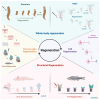Autophagy in Tissue Repair and Regeneration
- PMID: 39996754
- PMCID: PMC11853389
- DOI: 10.3390/cells14040282
Autophagy in Tissue Repair and Regeneration
Abstract
Autophagy is a cellular recycling system that, through the sequestration and degradation of intracellular components regulates multiple cellular functions to maintain cellular homeostasis and survival. Dysregulation of autophagy is closely associated with the development of physiological alterations and human diseases, including the loss of regenerative capacity. Tissue regeneration is a highly complex process that relies on the coordinated interplay of several cellular processes, such as injury sensing, defense responses, cell proliferation, differentiation, migration, and cellular senescence. These processes act synergistically to repair or replace damaged tissues and restore their morphology and function. In this review, we examine the evidence supporting the involvement of the autophagy pathway in the different cellular mechanisms comprising the processes of regeneration and repair across different regenerative contexts. Additionally, we explore how modulating autophagy can enhance or accelerate regeneration and repair, highlighting autophagy as a promising therapeutic target in regenerative medicine for the development of autophagy-based treatments for human diseases.
Keywords: autophagy; injury; planarian; regeneration; senescence; stem cell; tissue repair.
Conflict of interest statement
The authors declare no conflicts of interest.
Figures





References
Publication types
MeSH terms
Grants and funding
- 2021SGR00293/Agència de Gestió d'Ajuts Universitaris i de Recerca de la Generalitat de Catalunya
- CNS2023-144759/Consolidación Investigadora MICIU/AEI/10.13039/501100011033 and European Union Next-GenerationEU/PRTR
- PID2023-149733NB-I00/Ministerio de Ciencia, Innovación y Universidades; Spain
- FU2020-116372GB-I00/Ministerio de Ciencia e Innovación; Spain
- SECTEI/168/2021/Secretaria de Educación, Ciencia, Tecnología e Innovación de la Ciudad de México
LinkOut - more resources
Full Text Sources

